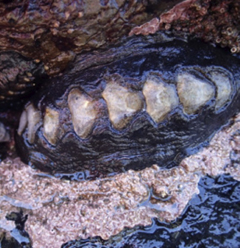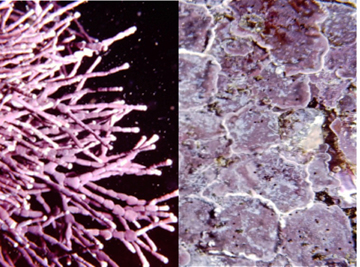Careers and Coralline Algae at Friday Harbor Laboratories
Florence McAlary
 Figure 1. Common residents of the intertidal zone of the islands, the black katy chiton (Katharina tunicata) and the dire whelk (Liabuccinium dirum). Photo credit: Florence McAlary.
Figure 1. Common residents of the intertidal zone of the islands, the black katy chiton (Katharina tunicata) and the dire whelk (Liabuccinium dirum). Photo credit: Florence McAlary.
The eye catches a splash of vibrant pink encrusting a tide pool rock, perhaps attended by whelks or a black katy chiton (Fig. 1). The vibrant pink is most likely a coralline alga. With branching tufts or a rugged, rock-conforming surface of calcareous encased cells, the colorful attribute of corallines underscores their significance to the marine community. Coralline algae are known world wide for their role in cementing reefs and providing critical habitat for the settlement and metamorphosis of numerous larval marine invertebrates including abalone. In the San Juan Islands, researchers at the Friday Harbor Laboratories delve into the mysteries and biology of this fascinating but little-understood group (Fig. 2).
The July issue of FHL Tide Bites details the coralline algae research of one young FHL scientist Rebecca Guenther. Rebecca initially came to FHL as an Adopt-a-Student scholarship recipient in the Marine Algae course. She fell in love with corallines and the opportunities that the Labs offered. She returned to FHL after the algology course, as do many scientists and students, to continue her studies as a Ph.D. candidate. Rebecca’s doctoral research takes advantage of the outstanding Ocean Acidification facility on campus and focuses on the calcification response of intertidal corallines to varying pH and temperature.
 Figure 2. Deposits of calcium carbonate in the cell walls give the coralline algae a hard texture. Growth forms vary from articulate branches to crustose thalli. Photo credit: Florence McAlary.
Figure 2. Deposits of calcium carbonate in the cell walls give the coralline algae a hard texture. Growth forms vary from articulate branches to crustose thalli. Photo credit: Florence McAlary.
This summer, abalone researchers Dr. Laura Rogers-Bennett and Dr. Cynthia Catton spent a month at FHL surveying subtidal coralline communities and collecting coralline samples from nearby Shark Reef for genetic analysis. Like Rebecca, Cynthia and Laura are concerned about the effects of changing ocean environments. Laura noted in her survey that coralline coverage and diversity on Shark Reef currently seemed ideal for the recruitment of our (now rare) northern abalone Haliotis kamtschatkana. She reported, with enthusiasm, that she actually found a live adult!
Neither Laura nor Cynthia are newcomers to FHL. Cynthia, now an Environmental Scientist with the California Department of Fish and Wildlife, participated in the first FHL Research Apprenticeship. The apprenticeship experience motivated her not only to follow a career in science, but to return to FHL numerous times to continue research and professional development. Laura spent two years as a Postdoctoral Fellow at the Labs before her appointment as a Research Associate at UC Davis and Senior Scientist with the California Department of Fish and Wildlife. Laura's kelp surveys in Puget Sound and microhabitat preference experiments with juvenile abalone helped to shape her current ecosystem-based critical habitat assessment.
Friday Harbor Laboratories is known as a hot spot for cutting edge research, with access to a wealth of biologically diverse marine communities and resources. These coralline algae stories demonstrate how opportunities for education, research, and professional growth can and do lead to a tradition of science excellence at FHL.



